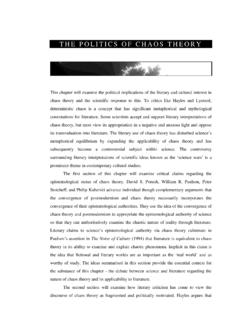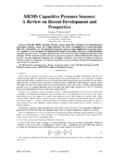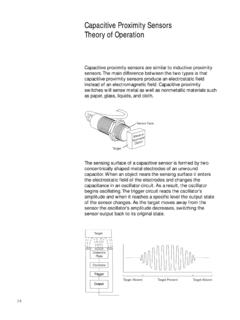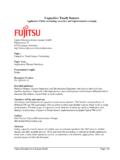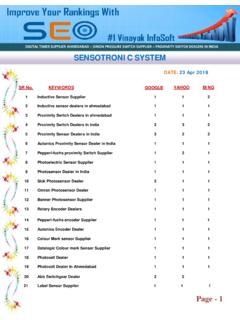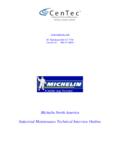Transcription of Sensing and Sensors: Acoustic Sensors - …
1 Sensing and Sensors : Acoustic Sensorsversion Lab, January 2008 References: Fraden: Handbook of Modern SensorsDrafts, Acoustic Wave SensorsBuff, SAW SensorsCady. Piezoelectricity: An Introduction to the Theory and Applications of Electromechanical Phenomena in : sound wavesSound waves are created by alternate compression and expansion of solids, liquids or gases at certain mechanical waves: oscillation in the direction of wave propagation'Sound' are longitudinal mechanical waves between 20 and 20khz, based only on our own hearing abilities / Mechanical waves below 20hz.
2 Are perceived by dogs and called Infrasound by your hearing and your audio equipment here: The Speed of SoundThe speed of sound depends on the medium through which the waves are passing, and is often quoted as a fundamental property of the material. In general, the speed of sound is proportional to the square root of the ratio of the elastic modulus (stiffness) of the medium to its density. Those physical properties and the speed of sound change with ambient conditions. For example, the speed of sound in gases depends on temperature. In air at sea level, the speed of sound is approximately 343 m/s, in water 1482 m/s, and in steel about 5960 m/s (at 20 C).
3 The speed of sound is also slightly sensitive (a second-order effect) to the sound amplitude, which means that there are nonlinear propagation effects, such as the production of harmonics and mixed tones not present in the original Sound as an waveform can be described in terms of its energy and the frequencies it can be decomposed intosound wave of a human voice in the time domain Signals are converted from time or space domain to the frequency domain usually through the Fourier transform. The Fourier transform(s) describe a decomposition of a function in terms of a sum of sinusoidal functions (basis functions) of different frequencies that can be recombined to obtain the original function.
4 The Fourier transform and its various derivatives form an important part of the art and science of digital signal processing (more on this later in the course).S(t) = 50mV . sin (2 pi 1000 t + pi/2) +100mV . sin (2 pi 2000 t + 0 ) +100mV . sin (2 pi 3000 t + 0 ) + .. + .. Human voice signal (5 seconds) and the corresponding frequency Power spectrum of a human whistle versus a human (male) voice Sound as a qualitative measure is often described as having the following components"Music components": * Pitch * Timbre * Harmonics * Loudness * Rhythm"Sound envelope components": * Attack * Sustain * Decay The pitch of a sound is determined by the frequency of the sound.
5 * low (bass) - sounds of thunder and gunshots * midrange - a telephone ringing * high (treble) - small bells and cymbalsTimbre is that unique combination of fundamental frequency, harmonics, and overtones that gives each voice, musical instrument, and sound effect its unique coloring and character. The harmonic of a wave is a component frequency of the signal that is an integer multiple of the fundamental frequency. 1f 440 Hz fundamental frequency first harmonic2f 880 Hz first overtone second harmonic3f 1320 Hz second overtone third harmonic4f 1760 Hzthird overtone fourth harmonicRhythm is a recurring sound that alternates between strong and weak elements Envelope of a soundpeakattacksustaindecaytime [seconds]loudness[dB] sound intensity is described by convention in Decibels :where the unit of is the decibel (dB) and , the 'sound threshold'Example.
6 30dB is the ratio between a base sound and a sound 1000 times more intensiveHere some notable sound levelsThreshold of hearing0dB ( = 0)heavy traffic80 dBNiagara Falls85 dBthreshold of pain120dBhydraulic press at 1m130dB =10log10 P1/P0 p0=10 12W/m2 Loudness, a subjective measure, is not equivalent to objective measures of sound pressure such as decibels or intensity. Research suggests that the human auditory system integrates intensity over a 600-1000 ms abstraction of loudness is sound intensity. Like several other physical properties (light and noise) sound intensity is measured in decibel, a logarithmic scaling.
7 The decibel scale linearizes a physical value in which exponential changes of magnitude are perceived by humans as being more or less linearly related; a doubling of actual intensity causes perceived intensity to always increase by roughly the same amount, irrespective of the original intensity 1000W/1W =30dB MicrophonesMicrophone: Acoustic Sensors for air waves in the audible range Hydrophone: Acoustic sensor for liquid wavesmicrophone / hydrophone are pressure Sensors with a wide dynamic microphone / hydrophone is a pressure transducer, adapted for the transduction of sound / liquid microphones / hydrophones have a moving diaphragm and a displacement tranducer that converts this motion into an electric / hydrophones differ by : sensitivity, direction characteristics, frequency bandwidth, dynamic range condensor microphones / capacitive microphonesbackground.
8 Capacitance, charge and voltage across two conducting plates a distance d apart+++++++++++-------------q++++++++++ +++qarea Avoltage Vdistance dV= q d / em e0 A em: material constante0: permitivity 10 12C2/Nm2 A capacitive microphone linearly converts a distance between plates into an electric device requires a source of electric charge (q) whose magnitude directly determines the microphone capacitive / condenser microphones are fabricated of silicon diaphragms that convert the Acoustic pressure of the sound wave into a (distance) displacementMechanical feedback.
9 Improves the frequency range of the microphone, but reduces deflection -> lower sensitivity fiber-optic microphonesPreferable where capacitive measurements are impossible (inside a rocket engine)Design: a single-mode temperature insensitive interferometer + reflective plate diaphragm. The interferometer emits a laser beam that is used to detect the plate deflection which is directly related to the Acoustic pressure. The phase of the reflected light will vary and differ from that of the (reflected reference light). Since both Sensing and reference light travel in the same light guide, they interfere resulting in light intensity modulation.
10 Such microphones can detect diaphragm movement in the order of 10 10m piezoelectric microphonesbackground: the piezoelectric effectA piezoelectric crystal is a direct converter of mechanical stress to electric charge. When compressed or pulled, a piezoelectric crystal will build up alternate charges on opposite faces, thus acting like a capacitor with an applied voltage. A current (piezoelectricity) can then be generated between the faces. When subjected to an external voltage, the crystal will expand or contract - 1882 The first experimental demonstration of a connection between macroscopic piezoelectric phenomena and crystallographic structure was published in 1880 by Pierre and Jacques Curie.

